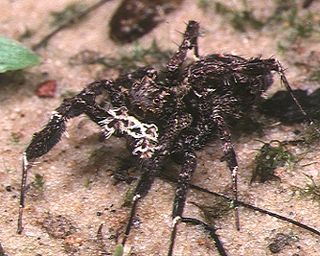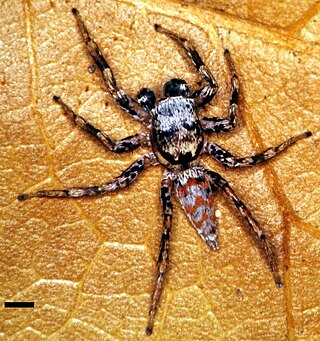
Sassacus is a genus of jumping spiders that was first described by George and Elizabeth Peckham in 1895. It is likely named after Sassacus, a Native American chief of the 16th and 17th century.

Vailimia is a genus of Asian jumping spiders. The type species was described in 1907 from a single male about 6 millimetres (0.24 in) long. It was originally thought to be close to Harmochirus, but the male pedipalp, chelicera, and cephalothorax drawn by Proszynski in 1984, and information gained from later collected specimens indicates otherwise. Subsequently, five more species have been identified. It may be a synonym for Pancorius.

Zygoballus is a genus of jumping spiders found in North and South America.

The Dendryphantina are a subtribe of jumping spiders that occur mainly in the New World. The subtribe was first defined by Anton Menge in 1879 as Dendryphantidae. Females of the subtribe generally show paired spots on the abdomen, and the males often have enlarged chelicerae. Females in this subtribe typically have S-shaped epigynal openings.

The Spartaeinae are a subfamily of the spider family Salticidae. The subfamily was established by Fred R. Wanless in 1984 to include the groups Boetheae, Cocaleae, Lineae, Codeteae and Cyrbeae, which in turn were defined by Eugène Simon.

Simonellini is a tribe of spiders belonging to the Amycoida clade of the subfamily Salticinae of the family Salticidae. The group has been treated at a variety of formal and informal ranks, with different circumscriptions, including as the subfamilies Synemosyninae and Simonellinae. Its species mimic ants and beetles.
Emertonius is a genus of spiders in the jumping spider family Salticidae.

Mexcala formosa is a species of jumping spider in the genus Mexcala that is endemic to Ethiopia. The spider was first defined in 2008 by Wanda Wesołowska and. It mimics ants, living alongside and preying upon them. Only the male has been described. It is a medium-sized spider, with a cephalothorax typically 2.9 mm (0.11 in) long and an abdomen typically 3.5 mm (0.14 in) long. The carapace is dark brown and the eye field black. The spider is similar to the related Mexcala agilis and Mexcala elegans, but can be distinguished by its thinner tibial apophysis and the white scales on its cymbium.

Mexcala smaragdina is a species of jumping spider in the genus Mexcala that is endemic to Nigeria. The spider was first defined in 2012 by Wanda Wesołowska and G. B. Edwards. Spiders of the genus mimic ants and ant-like wasps, living alongside and preying upon them. The spider is medium-sized, with a cephalothorax typically 2.5 mm (0.098 in) long and an abdomen 2.7 mm (0.11 in) long. The male has a hooked embolus that is shorter than the related Mexcala caerulea but otherwise the male copulatory organs are similar. The female has not been identified. The spider is most easily distinguished by the green-metallic sheen on its body, which is referred to in the species name.
Ragatinus is a genus of spiders in the family Salticidae. It was first described in 2016 by Angelika Dawidowicz and Wanda Wesołowska. As of 2017, it contains only one species, Ragatinus maddisoni.
Edwardsya is a genus of spiders in the family Salticidae. It was first described in 2016 by Ruiz & Bustamante. As of 2017, it contains 2 species, both from Brazil. The genus is placed in subtribe Freyina, part of the Salticoida clade in the subfamily Salticinae.
Hermosa is a genus of jumping spiders first described by G. W. Peckham and E. G. Peckham in 1892, and synonymized with Myrmarachne in 1901. In 2016, Jerzy Prószyński split up Myrmarachne, creating nine new genera, all with names beginning "Myrm". However, it turned out that Myrmavola volatilis, the type species of Myrmavola, was also the type species of Hermosa, and Myrmavola was made a junior synonym. It is part of the Myrmarachnini tribe within the Salticoida clade of Salticinae.

Hyllus nigeriensis is a species of jumping spider in the genus Hyllus that is endemic to Nigeria. It lives in rainforest. The spider was first described in 2012 by Wanda Wesołowska and G. B. Edwards. A medium-sized spider, it typically has a cephalothorax 4.1 mm (0.16 in) long and an abdomen 4.0 mm (0.16 in) long. The abdomen is reddish-brown and narrower than the light brown carapace. Originally tentatively allocated to the genus Brancus, the species was allocated to Hyllus in 2022. Only the female has been described.

Zygoballus minutus is a species of jumping spider in the genus Zygoballus that was first identified in Guatemala. The spider has also been found in Mexico, and the distribution may extend across Central America. Zygoballus minutus was first described by George and Elizabeth Peckham in 1898. It is a small spider, which is recalled in the name, which is the Latin for small, ranging in length between 3.5 and 4 mm. The male is distinguished by bands of white hair on the abdomen while the female has a pattern of streaks and bands. The palpal bulbs, which are reddish-brown on the male and yellow on the female, are also a distinguishing feature from other species in the genus.

Paramaevia is a genus of jumping spiders in the family Salticidae. There are at least three described species in Paramaevia.
Tartamura is a genus of South American jumping spiders first described by A. A. Bustamante & Gustavo Rodrigo Sanches Ruiz in 2017. Tartamura was placed in the tribe Thiodinini, part of the Amycoida clade of the subfamily Salticinae in Maddison's 2015 classification of the family Salticidae.
Spadera is a genus of jumping spiders containing the single species, Spadera unica. It was first described by George and Elizabeth Peckham in 1894, and has only been found in Madagascar.
Matinta is a genus of South American jumping spiders. The largest number of species are found in Brazil.

The Sitticini are a tribe of spiders in the family Salticidae. The tribe has been divided into two subtribes, Aillutticina, with five Neotropical genera, and Sitticina, with five genera from Eurasia and the Americas. One genus is unplaced within the tribe. The taxonomy of the tribe has been subject to considerable uncertainty. It was clarified in 2020.












